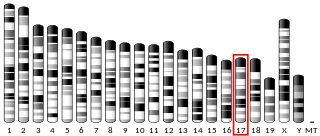Matrix metalloproteinases (MMPs), also known as matrix metallopeptidases or matrixins, are metalloproteinases that are calcium-dependent zinc-containing endopeptidases; other family members are adamalysins, serralysins, and astacins. The MMPs belong to a larger family of proteases known as the metzincin superfamily.
Protease inhibitors (PIs) are medications that act by interfering with enzymes that cleave proteins. Some of the most well known are antiviral drugs widely used to treat HIV/AIDS, hepatitis C and COVID-19. These protease inhibitors prevent viral replication by selectively binding to viral proteases and blocking proteolytic cleavage of protein precursors that are necessary for the production of infectious viral particles.

Lapatinib (INN), used in the form of lapatinib ditosylate (USAN) is an orally active drug for breast cancer and other solid tumours. It is a dual tyrosine kinase inhibitor which interrupts the HER2/neu and epidermal growth factor receptor (EGFR) pathways. It is used in combination therapy for HER2-positive breast cancer. It is used for the treatment of patients with advanced or metastatic breast cancer whose tumors overexpress HER2 (ErbB2).
Dz13 is an experimental treatment developed by scientists at the University of New South Wales. The drug aims to combat a range of illnesses, including skin cancer, restenosis, arthritis and macular degeneration. Trials of Dz13 were suspended in 2013.

Marimastat was a proposed antineoplastic drug developed by British Biotech. It acted as a broad-spectrum matrix metalloproteinase inhibitor.

Matrix metallopeptidase 9 (MMP-9), also known as 92 kDa type IV collagenase, 92 kDa gelatinase or gelatinase B (GELB), is a matrixin, a class of enzymes that belong to the zinc-metalloproteinases family involved in the degradation of the extracellular matrix. In humans the MMP9 gene encodes for a signal peptide, a propeptide, a catalytic domain with inserted three repeats of fibronectin type II domain followed by a C-terminal hemopexin-like domain.

72 kDa type IV collagenase also known as matrix metalloproteinase-2 (MMP-2) and gelatinase A is an enzyme that in humans is encoded by the MMP2 gene. The MMP2 gene is located on chromosome 16 at position 12.2.

Matrilysin also known as matrix metalloproteinase-7 (MMP-7), pump-1 protease (PUMP-1), or uterine metalloproteinase is an enzyme in humans that is encoded by the MMP7 gene. The enzyme has also been known as matrin, putative metalloproteinase-1, matrix metalloproteinase pump 1, PUMP-1 proteinase, PUMP, metalloproteinase pump-1, putative metalloproteinase, MMP). Human MMP-7 has a molecular weight around 30 kDa.

Matrix metalloproteinase-26 also known as matrilysin-2 and endometase is an enzyme that in humans is encoded by the MMP26 gene.

Stromelysin-3 (SL-3) also known as matrix metalloproteinase-11 (MMP-11) is an enzyme that in humans is encoded by the MMP11 gene.

Matrix metalloproteinase-25 is an enzyme that in humans is encoded by the MMP25 gene.
A matrix metalloproteinase inhibitor inhibits matrix metalloproteinases. Because they inhibit cell migration, they have antiangiogenic effects. They may be both endogenous and exogenous.
Metalloprotease inhibitors are cellular inhibitors of the Matrix metalloproteinases (MMPs). MMPs belong to a family of zinc-dependent neutral endopeptidases. These enzymes have the ability to break down connective tissue. The expression of MMPs is increased in various pathological conditions like inflammatory conditions, metabolic bone disease, to cancer invasion, metastasis and angiogenesis. Examples of diseases are periodontitis, hepatitis, glomerulonephritis, atherosclerosis, emphysema, asthma, autoimmune disorders of skin and dermal photoaging, rheumatoid arthritis, osteoarthritis, multiple sclerosis, Alzheimer's disease, chronic ulcerations, uterine involution, corneal epithelial defects, bone resorption and tumor progression and metastasis. Due to the role of MMPs in pathological conditions, inhibitors of MMPs may have therapeutic potential. Several other proteins have similar inhibitory effects, however none as effective. They might have other biological activities which have yet been fully characterised.

Matrix metalloproteinase-21 (MMP-21) is an enzyme that in humans is encoded by the MMP21 gene.

Matrix metallopeptidase 27 also known as MMP-27 is an enzyme which in humans is encoded by the MMP27 gene.
A CDK inhibitor is any chemical that inhibits the function of CDKs. They are used to treat cancers by preventing overproliferation of cancer cells. The US FDA approved the first drug of this type, palbociclib (Ibrance), a CDK4/6 inhibitor, in February 2015, for use in postmenopausal women with breast cancer that is estrogen receptor positive and HER2 negative. While there are multiple cyclin/CDK complexes regulating the cell cycle, CDK inhibitors targeting CDK4/6 have been the most successful, with 4 CDK4/6 inhibitors haven been FDA approved. No inhibitors targeting other CDKs have been FDA approved, but several compounds are in clinical trials.

Tanomastat is a matrix metalloproteinase inhibitor (MMPI).

Prinomastat is a matrix metalloproteinase (MMP) inhibitor with specific selectivity for MMPs 2, 3, 9, 13, and 14. Investigations have been carried out to determine whether the inhibition of these MMPs is able to block tumour metastasis by preventing MMP degradation of the extracellular matrix proteins and angiogenesis. Prinomastat underwent a Phase III trial to investigate its effectiveness against non-small cell lung cancer (NSCLC), in combination with gemcitabine chemotherapy. However, it was discovered that Prinomastat did not improve the outcome of chemotherapy in advanced non-small-cell lung cancer.

Kadmon Corporation is a biopharmaceutical company based in New York City. It also has operations in Warrendale, PA and Brighton, MA. The company was founded in 2009 by Samuel D. Waksal, founder and former CEO of ImClone Systems, now fully merged into Eli Lilly and Company. Waksal had served a federal prison sentence stemming from his fiduciary role as CEO in the 2001 ImClone stock trading case. When released in 2009 he was barred from serving as an officer for any publicly traded company but Kadmon was privately financed.
CUSP9 [Coordinated Undermining of Survival Paths] is one of several cancer treatment protocols using re-purposed older drugs to interfere with cancer cell's growth signaling rather than directly killing them with cytotoxic drugs. CUSP9 is a treatment specifically targeted to glioblastoma that adds to a traditional cancer cell killing drug, temozolomide, nine older, non-cytotoxic drugs to block growth factors that enhance or drive glioblastoma growth - aprepitant blocks NK-1, auranofin inhibits thioredoxin reductase, captopril inhibits angiotensin converting enzyme, celecoxib blocks cyclooxygenase-2, disulfiram blocks aldehyde dehydrogenase, itraconazole blocks Hedgehog signaling, minocycline inhibits metalloproteinase-2 and -9, quetiapine inhibits RANKL, sertraline inhibits translation-controlled tumor protein [TCTP]. These targets have been shown to be active in promoting glioblastoma growth.












